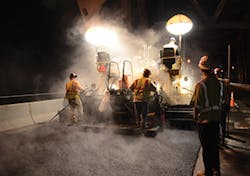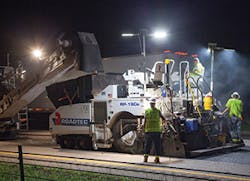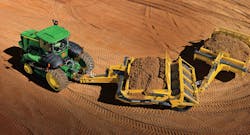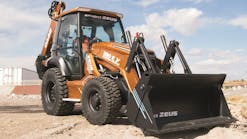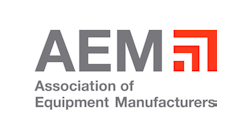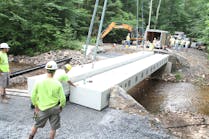The agency points out safety considerations are increasing for highway workers as a result of the combination of more work done alongside increasingly heavier traffic and greater use of night work.
According to a National Cooperative Highway Research Program (NCHRP) report based on work zone crash data from more than 17,000 crashes studied in California, North Carolina, Ohio, and Washington, working at night does not result in a significantly greater crash risk for an individual motorist traveling through the work zone than it does working during the day.
However, injuries and even fatalities do occur, and for grading and excavation contractors doing road work, it’s important to know the driving factors behind road work injuries.
More than 20,000 workers are injured each year in road construction work zones. Studies conducted between 2003 and 2008 show 35% were caused by contact with objects or equipment; 20% by slips, trips, or falls; 15% by overexertion; 12% by transportation incidents; and 5% by exposure to harmful substances or environments.
Fatalities at road construction sites typically account for 1.5–3% of all workplace fatalities annually. In 2010, there were 106 workplace fatalities at road construction sites; roadway construction worker fatalities reached a high point in 2005 with 165 fatalities.
Numbers declined between 2005 and 2008, rose slightly in 2009, and declined again in 2010.
The most common cause of construction worker fatalities is runovers/backovers, often by dump trucks. In 2010, that accounted for 43% of construction worker fatalities.
The second most common cause of worker fatalities are collisions between vehicles/mobile equipment, causing 19% of worker fatalities in 2010.
The third most common cause of worker fatalities—8% in 2010—are workers caught between or struck by construction equipment and objects.
There are regulations and measures to help ensure safety.
With improved safety measures on a nighttime construction site, grading and excavation contractors face fewer liability issues with respect to the safety of workers and drivers who pass by construction sites. Efficiencies improve.
Lighting is one of the most significant factors on a nighttime job site.
In the report Nighttime Lighting Guidelines for Work Zones, the American Traffic Safety Services Association states that state departments of transportation that do not have lighting specifications for work zones should use the guide to develop specifications for contractors to use to improve safety of both workers and the traveling public in work zones at night.
The organization also advises all agencies that perform road work at night to train their key personnel in minimum lighting requirements, needs, and best practices by project and work activity.
The key steps in developing a light plan are to:
- Determine work activities and lighting levels
- Determine the work zone area to be illuminated
- Select type of lighting source
- Select fixture locations
- Check design for adequacy
The guide also may be used to facilitate training sessions, discussions, and improvements in practice for both public and private sector stakeholders to ensure lighting schemes in nighttime work zones accomplish vital objectives.
NCHRP has developed a set of illumination guidelines based on work zone task illumination requirements. Its three categories are based on considerations such as minimum lighting levels recommended by the Illuminating Engineering Society (IES), federal and state lighting requirements and guidelines, research, and expert opinions.
Level I illuminance is recommended in areas where the work crew is in motion and is appropriate for tasks requiring low accuracy, involving slow-moving equipment, and where large objects are visible. Possible tasks include setup of lane or road closures, lane closure tapers, and flagging stations. The average minimum maintained illuminance is 54 lux (five foot-candles).
Level II illuminance is recommended for areas on or around construction equipment to provide a safer environment for the workers operating the equipment, allowing them to perform tasks that require a moderate level of accuracy, such as asphalt paving, milling, and concrete placement/removal. The average minimum maintained illuminance is 108 lux (10 foot-candles).
Level III illuminance is recommended for tasks that require a greater level of visual acuity or for tasks with a higher level of difficulty, such as pavement or structural crack/pothole filling, joint repair, pavement patching/repairs, and installation of signal/electrical/mechanical equipment. The average minimum maintained illuminance is 215 lux (20 foot-candles).
Types of temporary lighting systems for work zones include portable light plant towers, consisting of numerous luminaires mounted to a mast arm capable of holding the luminaires at various mounting heights. The mast arm is attached to a trailer with a generator that can be towed by a vehicle.
To prevent glare, it is suggested these lighting systems should not be aimed toward traffic but aimed downward at the work site and rotated outward no greater than 30 degrees from straight down unless the light has been designed specifically to prevent glare.
Balloon lighting consists of a large balloon-type luminaire that provides a fairly large area of evenly distributed, glare-free light and can be mounted on slow-moving equipment or portable light towers.
Roadway luminaires mounted on temporary poles are any permanent roadway lighting fixture mounted on temporary poles and hard-wired to an electrical system and is prepared by a lighting design professional.
Another form of lighting is factory-installed lights on equipment.
Ingmar Hansen, vice president of POWERMOON, notes that while there are often police vehicles with flashing lights on nighttime construction sites, “I’ve heard some people say the lights they have on them are so powerful that they are blinding you when you drive through.”
Providing “daylight at night” is the aim of POWERMOON. The company’s shadow-reduced light products resemble daylight and are designed to make it easier to see the work site.
The lighting balloon with its elliptic shape, light-diffusing lower cover and light-reflecting upper cover is designed to be glare-free and shadow-reduced, with the ability to spread light in a 360-degree circle without any dark spots.
POWERMOON features “umbrella style” technology that opens and closes the balloon cover without air pressure or gas. It is designed to be set up on a stationary lighting system or transported along moving machinery on construction sites on roads and highways.
POWERMOON balloons are constructed from heavy-duty materials such as stainless steel, aluminum, and Kevlar. The lighting balloons are weatherproof.
Four 1000-watt metal halide units are enough to light up an area the size of a football field.
The POWERMOON is designed to provide improved visibility so that contractors can more easily view their activities, communicate more easily, and experience less fatigue during evening work. Additionally, passing traffic is less blinded and distracted by glare.
“More light is better,” says Hansen. “But it has to go along with quality. A sunny day is usually not as good of a workday as a day when the sun is covered by high clouds. That’s when you have maximum light with maximum quality as you are not blinded and have no harsh shadows.”
That’s the environment POWERMOON creates. “Our approach is primarily the glare-free and portable approach. In a lot of other cases, lighting simply more leads to more glare and stronger shadows and ‘hot spots’ that are rather tiring and inefficient,” explains Hansen.
Hansen says lighting is best set up in one or two spots, when it can be available to light all of the different places on a construction site in which contractors work.
As a portable light, the POWERMOON enables contractors to mount lights on each piece of equipment as desired, such as the paver, roller, and broom.
“Each unit or machine should be equipped with a light that surrounds the area as well as the equipment itself where the operator is working,” notes Hansen.
In the past few years, POWERMOON has heavily invested in LED technology, such as its 560-watt POWERMOON LED Valuemaster and the POWERMOON LED Master Lighting Balloon, a product that sets up in 10 seconds and offers up to 65,000 lumen and illuminates an area of about 25,000 square feet.
Hansen notes LED allows for a better color rendering.
“It’s a whiter light than any other light bulb would put out in the past, which allows for a better understanding and viewing of the surrounding because everything appears more as it was in sunlight than it would be with metal halide or halogen light,” he says.
Hansen says the company’s lights work on 110 volts as well as 12- or 24-volt set-ups.
Lighting is crucial to night roadwork safety.
“With the new LED technology, they can produce a high lumen level by using the battery on the machine,” he adds. “LED is so much more energy-efficient. Usually, you would only find an integrated generator on a paver, but now you can also run it off the battery on a roller or broom.”
Doosan Portable Power’s light towers are designed to make the job safer, says Deree Bivins, manager of lighting systems.
The company offers a range of light towers, including balloon-types, tripod stand, pole-mount, and vehicle-attached models. The company also offers a variety of generators.
“Glare-free lights are often attached to pavers, lighting the asphalt that they’re laying,” says Bivins. “Those are also chosen by flaggers to light where they work. There are more accidents backing the asphalt trucks into the person directing them because the area was not lit correctly or they were in the blind spot.”
Light towers that are not set up correctly is one of the biggest mistakes Bivins observes on a construction site as well as lights not being positioned to provide optimal coverage.
“They should be level,” Bivins points out. “There are outriggers and jacks on all of the light towers to keep them level.”
Doosan Portable Power also offers a bubble level on all of its light towers so that contractors know they are level when setting them up.
“Our tallest tower is 30 feet and then you’ve got a good bit of weight when it comes to the lamp,” says Bivins. “Your initial setup needs to be done correctly so that you don’t have an issue.”
Doosan Portable Power towers meet or exceed the industry standard of handling 65 miles per hour wind gusts, Bivins points out.
Joanna Peddicord, product manager, material transport vehicles and pavers for Roadtec, agrees that visibility is the major concern on a nighttime road-building project.
“Visibility not only encompasses all of the workers on the job site, but it encompasses all of the motorists that pass by the area as well,” she adds. “There are multiple ways to improve visibility: high-visibility apparel, setting up signs, or hardware to account for longer reaction times, headlights, warning lights, and temporary lighting.”
Work site safety can be continually improved by staying up-to-date on OSHA regulations and by referencing the Manual on Uniform Traffic Control Devices (MUTCD), says Peddicord.
“Proper personal protective equipment should also be worn at all times and may vary for different job sites,” she adds. “It is a must to keep visibility in mind. Everything in the work site must be readily visible while producing as little glare as possible to passing traffic.”
Peddicord emphasizes that an optimal way to improve visibility is by implementing lighting to better illuminate the work site.
“One such product is the LED Blade Light provided by Carlson,” she says. “Not only does this light consume less power than its halogen equivalents, but it also produces far less heat. Crews will no longer have to wait for the apparatus to cool down before packing up at the end of the work day, which adds to the benefits of this light.”
Peddicord adds that these lights are low profile, causing little distraction to passing vehicles and have a wide range of motion.
“By simply taking advantage of the wide range of motion, the LED Blade Light will provide the crew with ample lighting while keeping the passing traffic from receiving any glare that will affect their driving capabilities,” she says.
One of the most common nighttime construction projects is bridge paving, says Dean Johnson, service manager for Terex Bid-Well.
“In the South, bridge paving is often conducted at night during the summer when it’s cooler so the concrete doesn’t prematurely dry,” he says. “Additionally, the traffic counts are lower during the night hours, which reduces the number of vehicles driving by a paving project.”
Two of the biggest mistakes Johnson sees on construction sites during night work are unlit signage and “confusing” traffic flow changes.
“If signs aren’t properly lit, they can be missed by drivers, which can create confusion and lead to accidents,” he says. “Also, not having the appropriate amount of lights leading up to the job site can create issues. A car traveling at construction zone speeds can quickly come up to a job site that is well-lit and temporarily blind drivers while their eyes adjust.”
Additionally, traffic that is speeding through a bridge construction zone can not only lead to potentially dangerous situations, but this action also can create cracking in the new road surface on a concrete overlay project, Johnson points out.
“It is important that reduced construction zone speeds be enforced so contractors can deliver a quality product in these overlay applications,” he adds.
The type of lighting used on nighttime construction projects is important, says Johnson.
“Traditional halogen tower lights can create harsh shadows and can impair the vision of drivers if not properly positioned,” he adds. “Balloon-type lights are a good alternative to tower lights as they light up the area without creating the harsh shadows. Individual equipment lighting is also important, especially for equipment with moving parts.”
Terex Bid-Well has an LED lighting system for its paver customers to use for nighttime projects.
“It illuminates the paving carriage, so it can be easily seen as it moves along the frame across the bridge deck or concrete slab,” says Johnson.
The light system is used for the company’s line of concrete bridge, flatwork, highway, airport, and canal pavers, as well as powered work bridges and texture/curing machines. The package mounts directly to the equipment’s frame and the paver’s paving carriage and helps to reduce the shadows cast by tower lights.
The lights are powered directly by the machine’s engine, so contractors do not need a supplemental generator to run them, says Johnson. Up to 12 lights can be positioned on the machine’s frame and at the ends of the paver, allowing workers to finish the edges of the deck without battling shadows. Up to four additional lights can be mounted directly to the paving carriage so workers can clearly see the location of the carriage as it moves back and forth along the frame.
One additional benefit to the lights: “They do not generate the heat of halogen lights, so the risk of prematurely drying out the concrete or burning a worker is eliminated,” Johnson notes.
Having a reflective vest in the correct color also is important, he adds. Johnson had been present on a paving project on the English Tunnel connecting England and France where there had been multiple instances of workers being struck by vehicles.
“A study of personal protective equipment was conducted, and researchers found that the best vest for that particular job site was the safety green vest with reflective tape,” he says.
Steve Howard, manager of product safety for Wirtgen America, echoes others in the industry by placing illumination at the top of the night work safety list.
“There are difficulties especially with road equipment; it’s not like a static work site,” he says. “Proper illumination around the work site ensures people can see work is being done and the people around them with the equipment. Each state has its own illumination requirements for the work zone.”
Reflective personal protective equipment required by OSHA meeting the American National Standards Institute standards is also critical, he adds.
A third factor that presents nighttime road construction challenges: sleep deprivation.
“With more night work, you have people who become sleep-deprived,” says Howard. “That becomes an issue with people working a second job and coming out and working at a night job. You might have to worry about people who aren’t fully awake. It’s very difficult to work at night shifts with the sleep deprivation of the employees who are out there sometimes.”
Mistakes often occur due to complacency, notes Howard.
“When you’re working along a highway and you have a lot of traffic that is going by, people will actually walk out into traffic or you may have somebody who falls asleep at the wheel or is drunk driving that may enter your work zone,” he says. “Even though you might think of where you are as safe, that doesn’t necessarily mean that it’s true.”
If permitted, one measure contractors can use to beef up safety during night jobs are concrete Jersey barriers instead of cones, says Howard.
“A lot of jobs are called ‘mill and fill’ where they will mill up a section of highway overnight and then in the same evening, they’ll be putting fresh asphalt right back in there,” says Howard. “That’s a rolling job site and to have that lane restriction, those plastic cones won’t stop anybody from entering into your job site.”
Not only does a contractor have to be concerned about his or her own company’s equipment, but possibly that of other companies that also are working on the same job site, he adds.
“Even though you might think that you are safe and you’re doing the right thing for safety with your piece of equipment, another piece of equipment might hit you,” he points out.
Wirtgen America offers illumination kits that can be mounted on its equipment, especially pavers and milling machines.
A contractor’s preparation for a night shift is critical to setting himself or herself up for success and minimizing risk for fatigue, points out Todd Dawson, a safety subject matter expert for Caterpillar.
“A common but highly effective way to do this is to try to nap prior to leaving to start your shift,” says Dawson. “Even a 30-minute nap can boost your alertness levels for the next four to five hours while a 90-minute nap can give you as much as a 40% increase in alertness for eight to nine hours.”
This doesn’t mean it is acceptable to skip sleep and just take the nap, he adds.
“The goal is to try to get a minimum of five hours of daytime sleep between night shifts and fill in with naps prior to starting work,” says Dawson.
Other tips for minimizing fatigue risk include:
- Managing caffeine intake and using it during times when an extra boost is needed, in contrast to a steady stream of caffeine.
- Maintaining a healthy diet both on and off shift and trying to avoid sugar during the night shift. “Sugar gives a great boost of energy but it only lasts a short time and is followed by a severe crash, requiring more sugar to bring you back to where you started,” Dawson points out.
- Exercising regularly. “In addition to the general health benefits of regular exercise, there are also benefits to your sleep and night work activities,” says Dawson. “Studies have shown that people who exercise regularly adapt to changes in their sleep/wake schedule faster than those who don’t. Regular exercise also improves the quality of sleep and reduces the time it takes to fall asleep.”
For those doing nighttime construction work, Caterpillar Safety Services offers a holistic solution based on a Fatigue Risk Management System (FRMS). The Caterpillar FRMS builds several layers of protection to minimize fatigue risk. These core layers of protection include: training and education, scheduling and rosters, policies and procedures, fatigue mitigating/measurement technology, and fatigue/safety culture.
